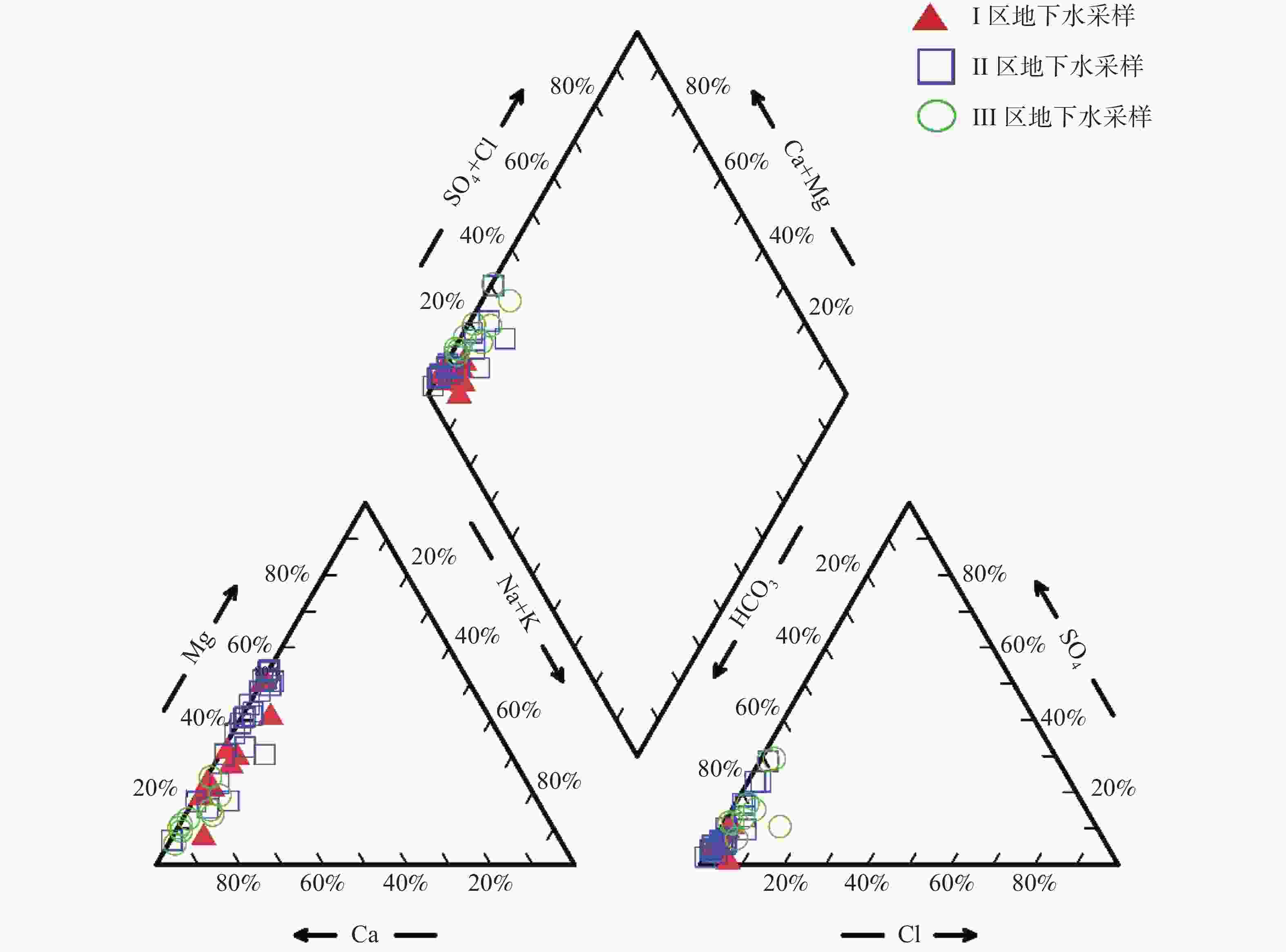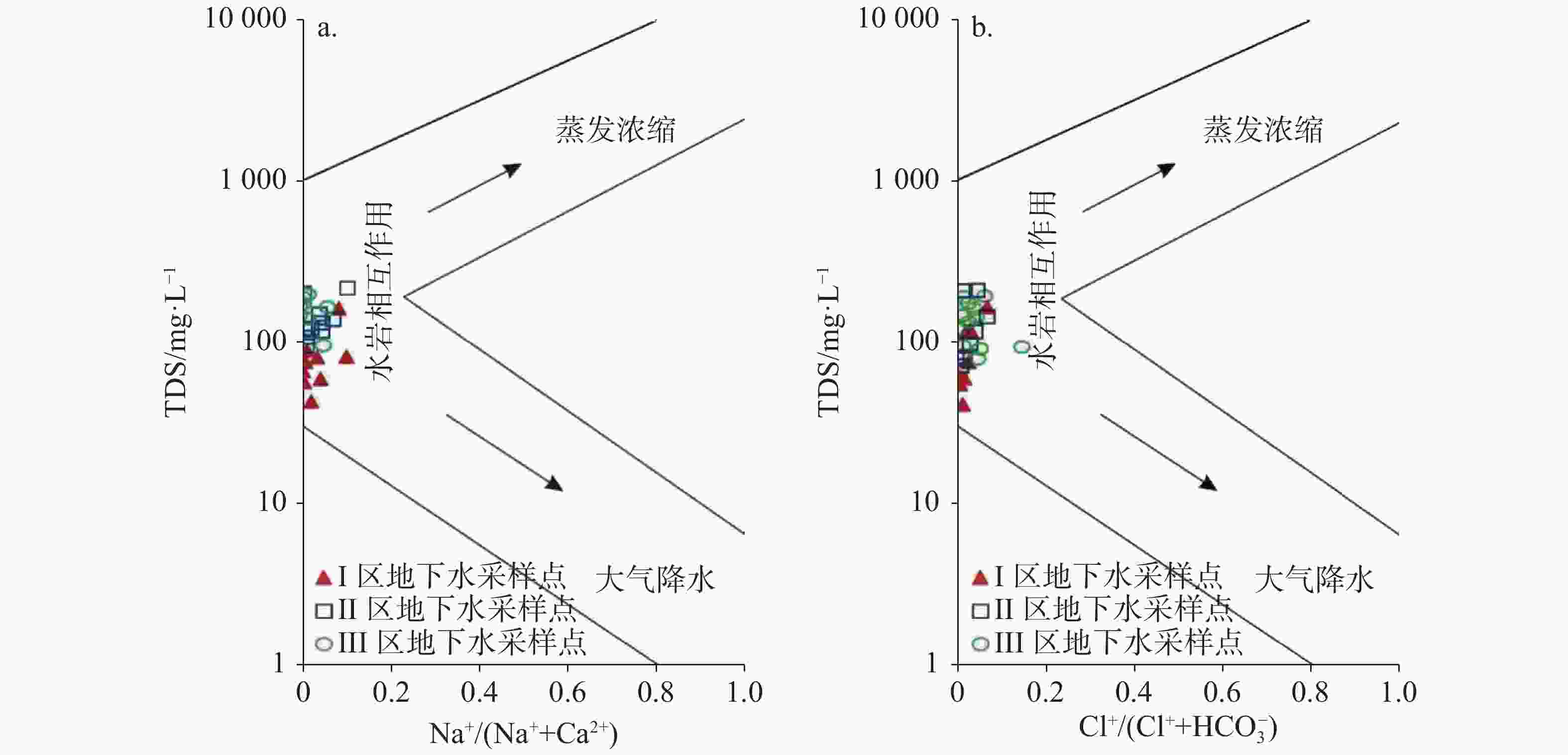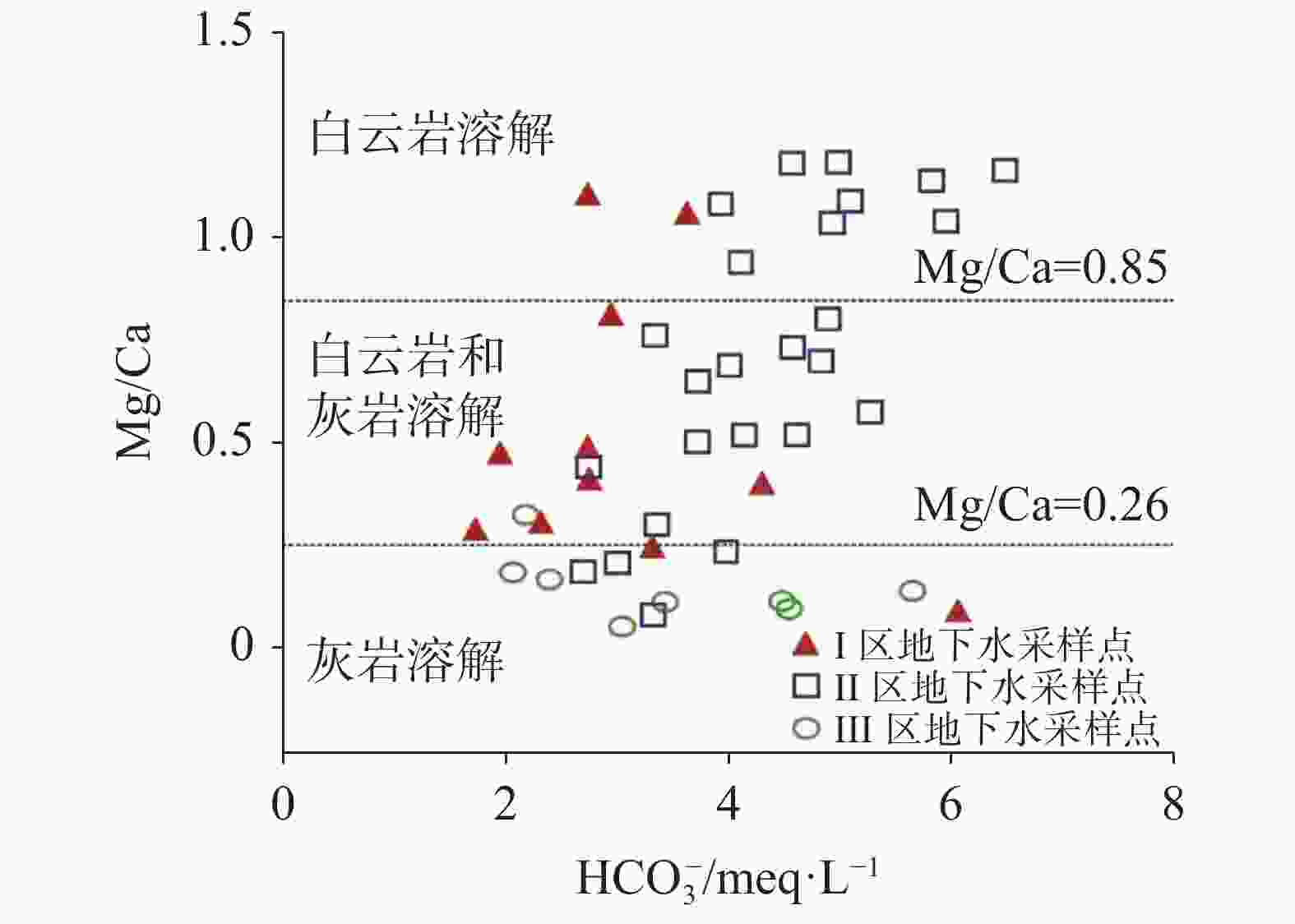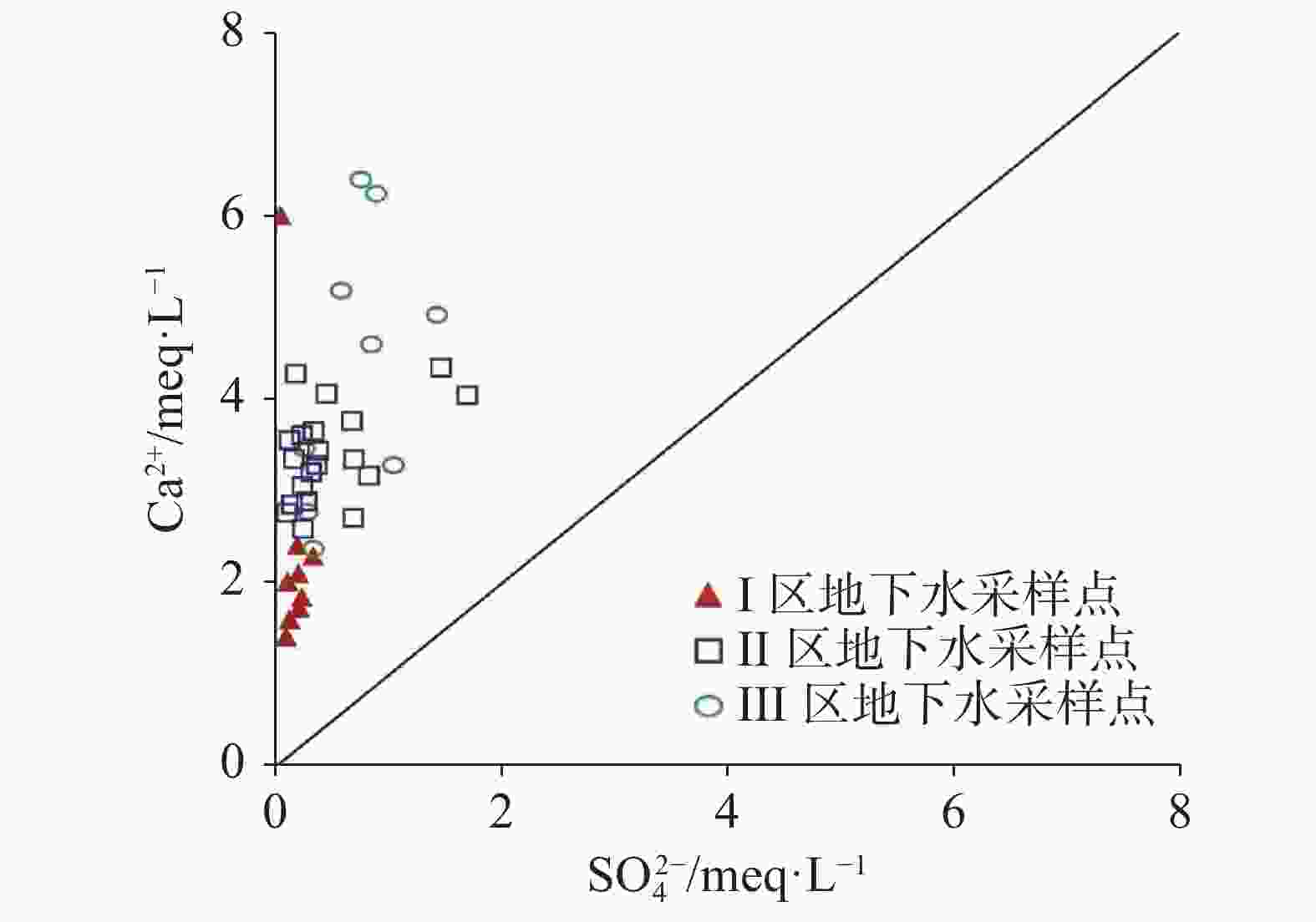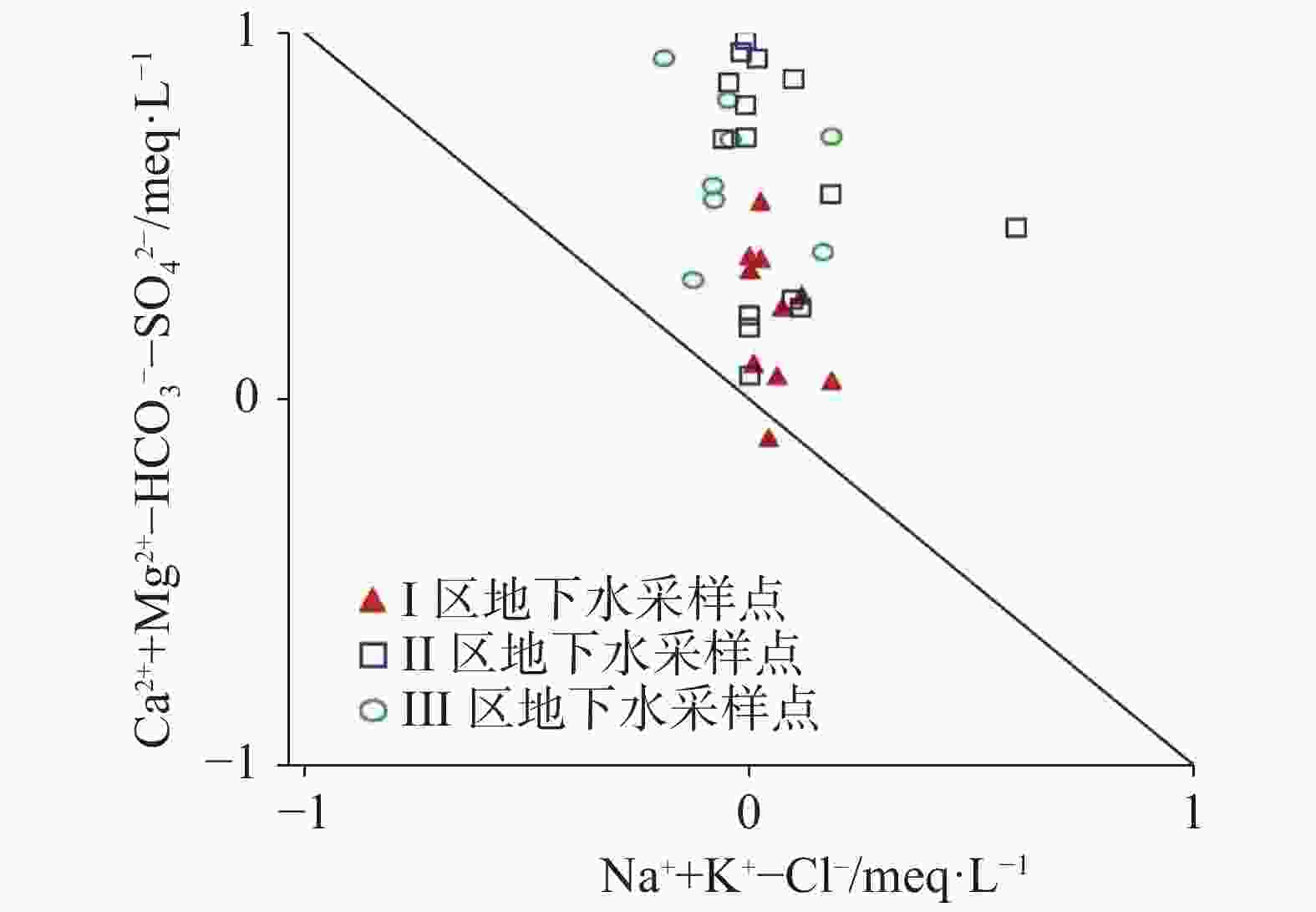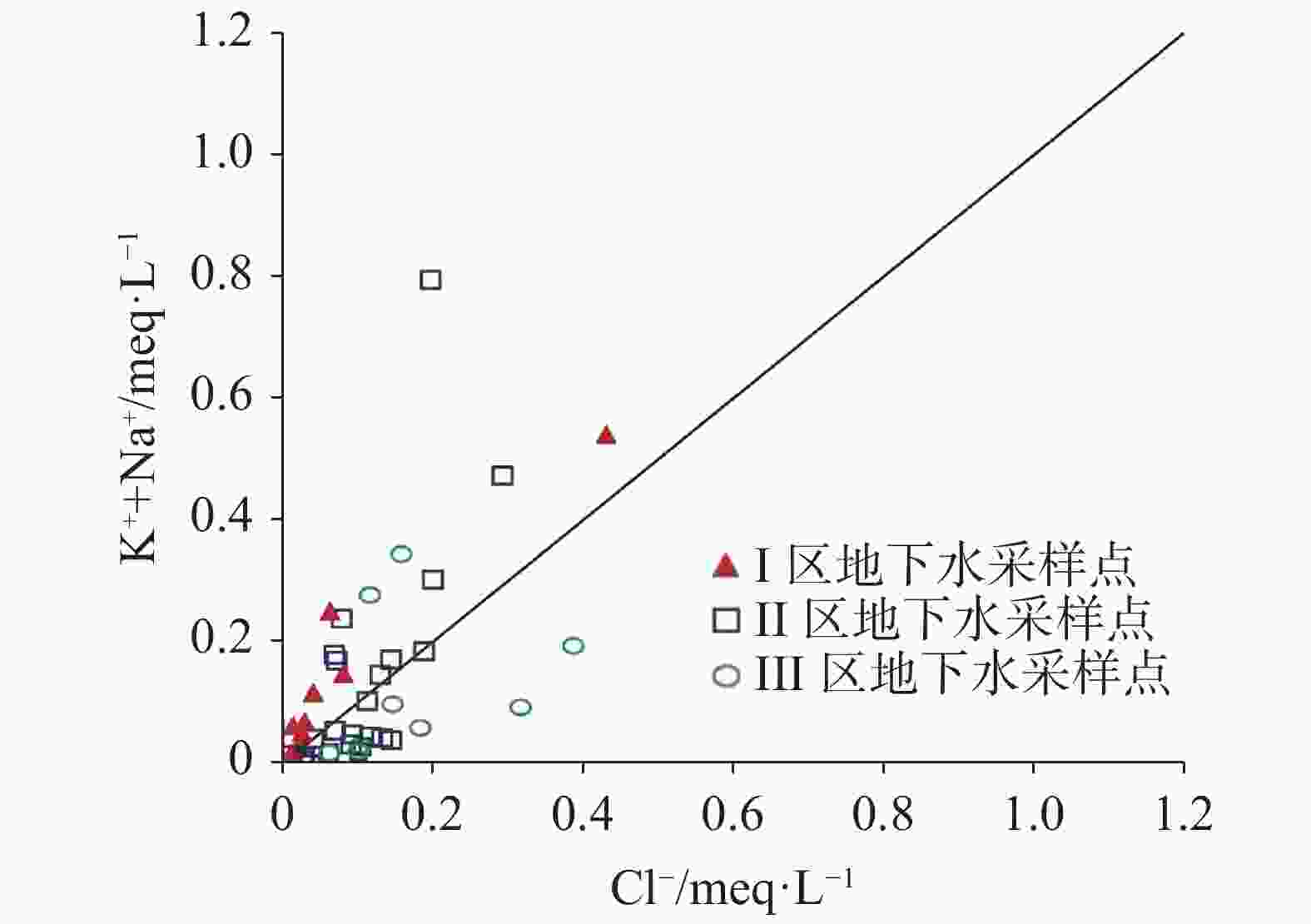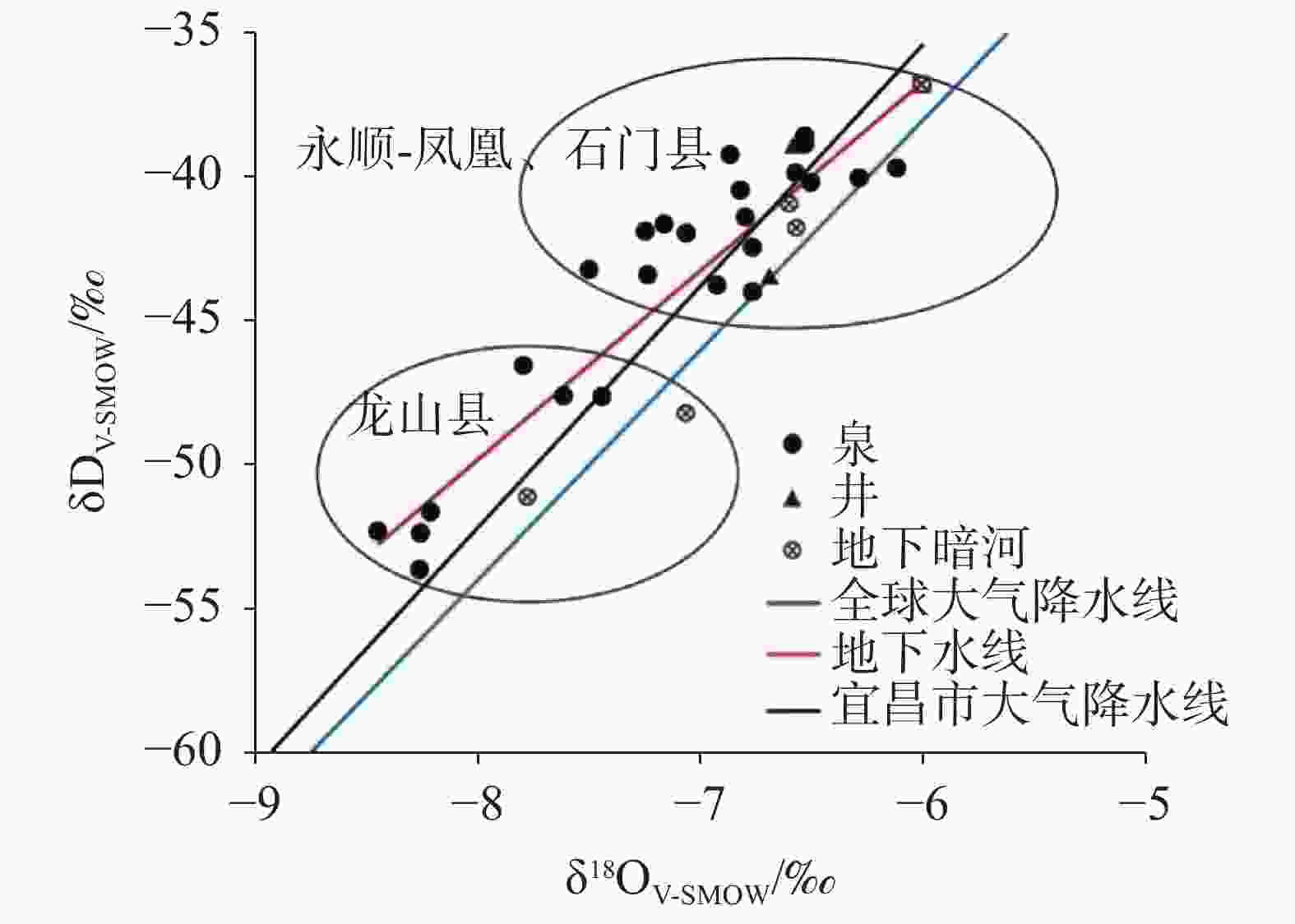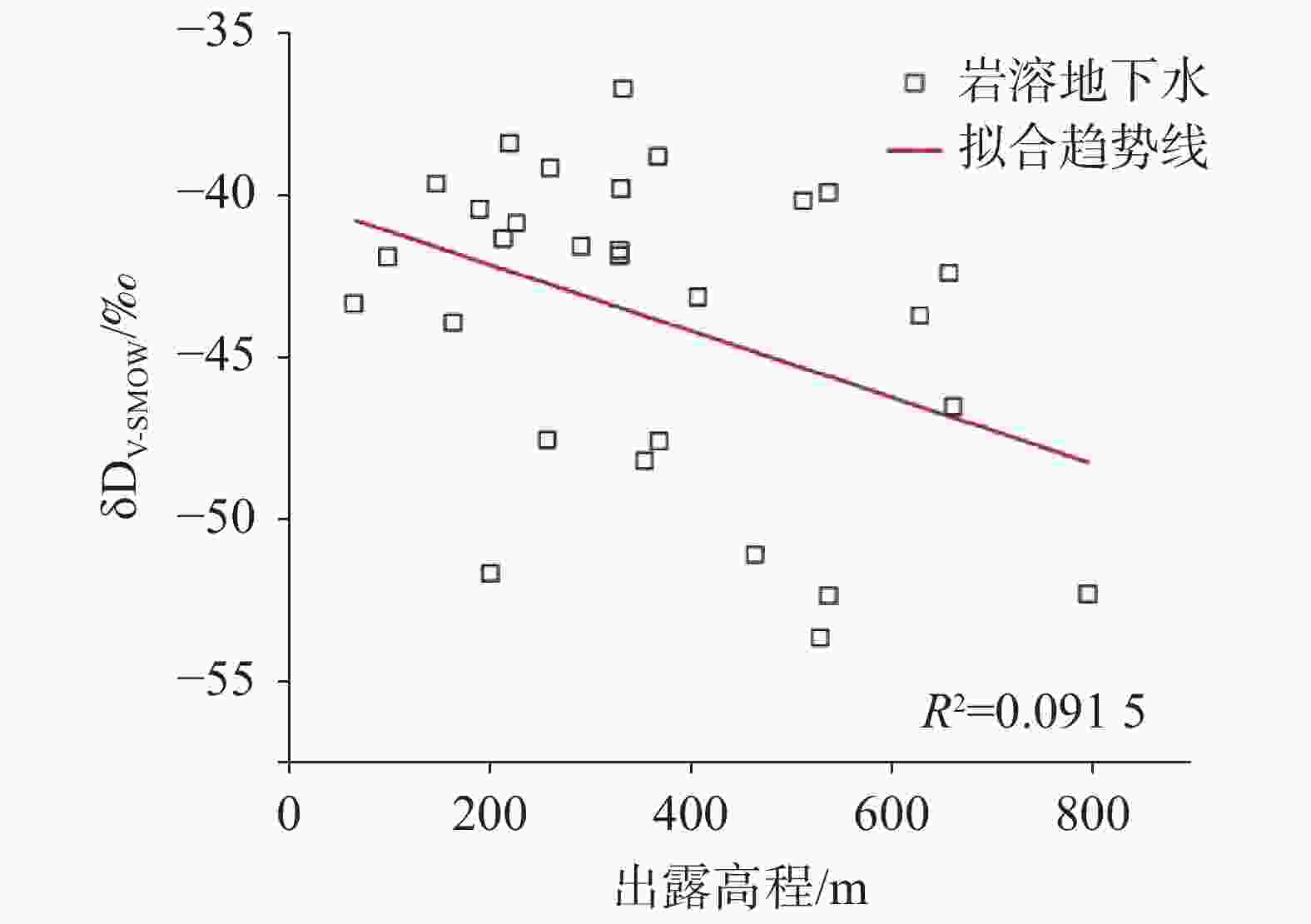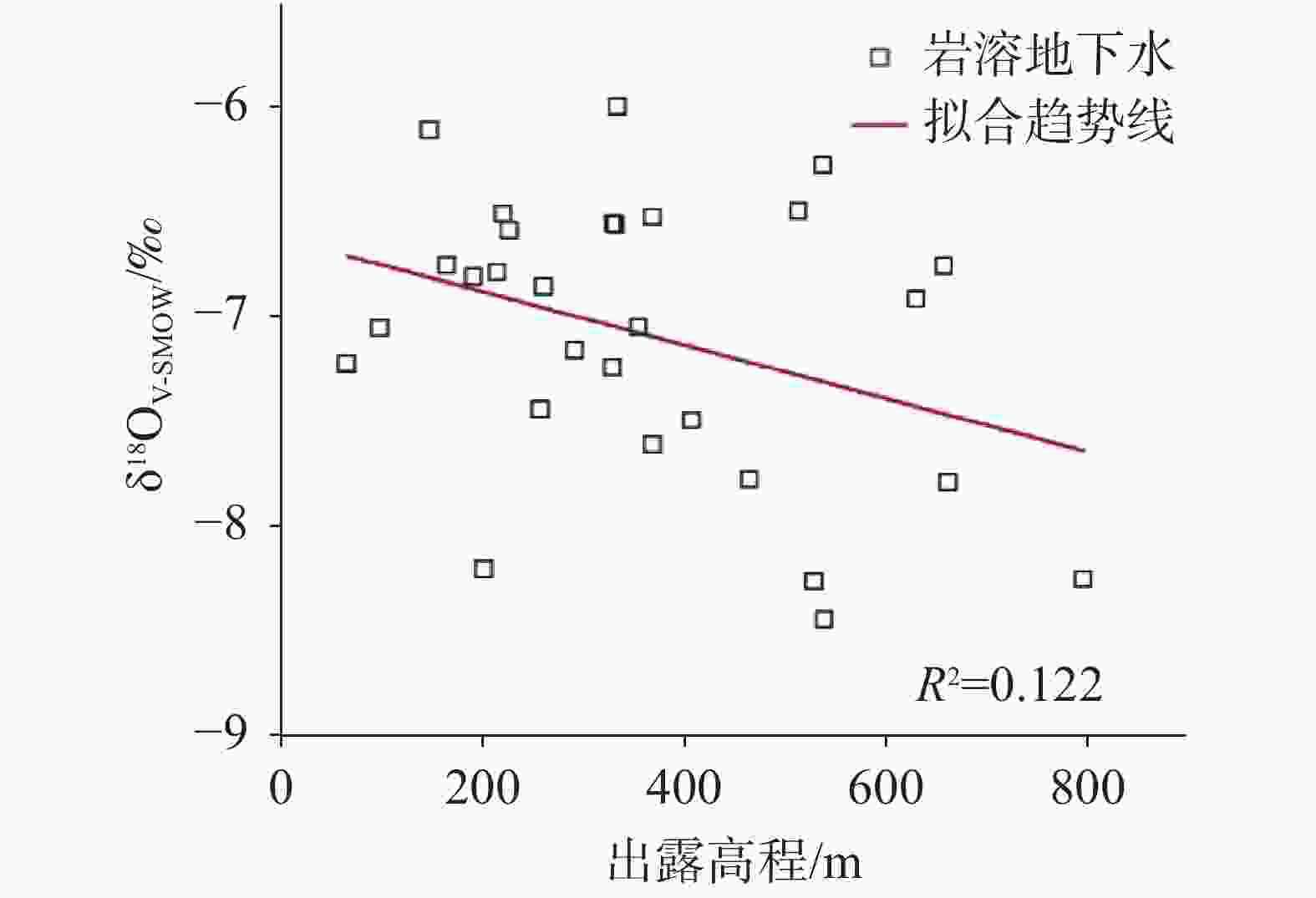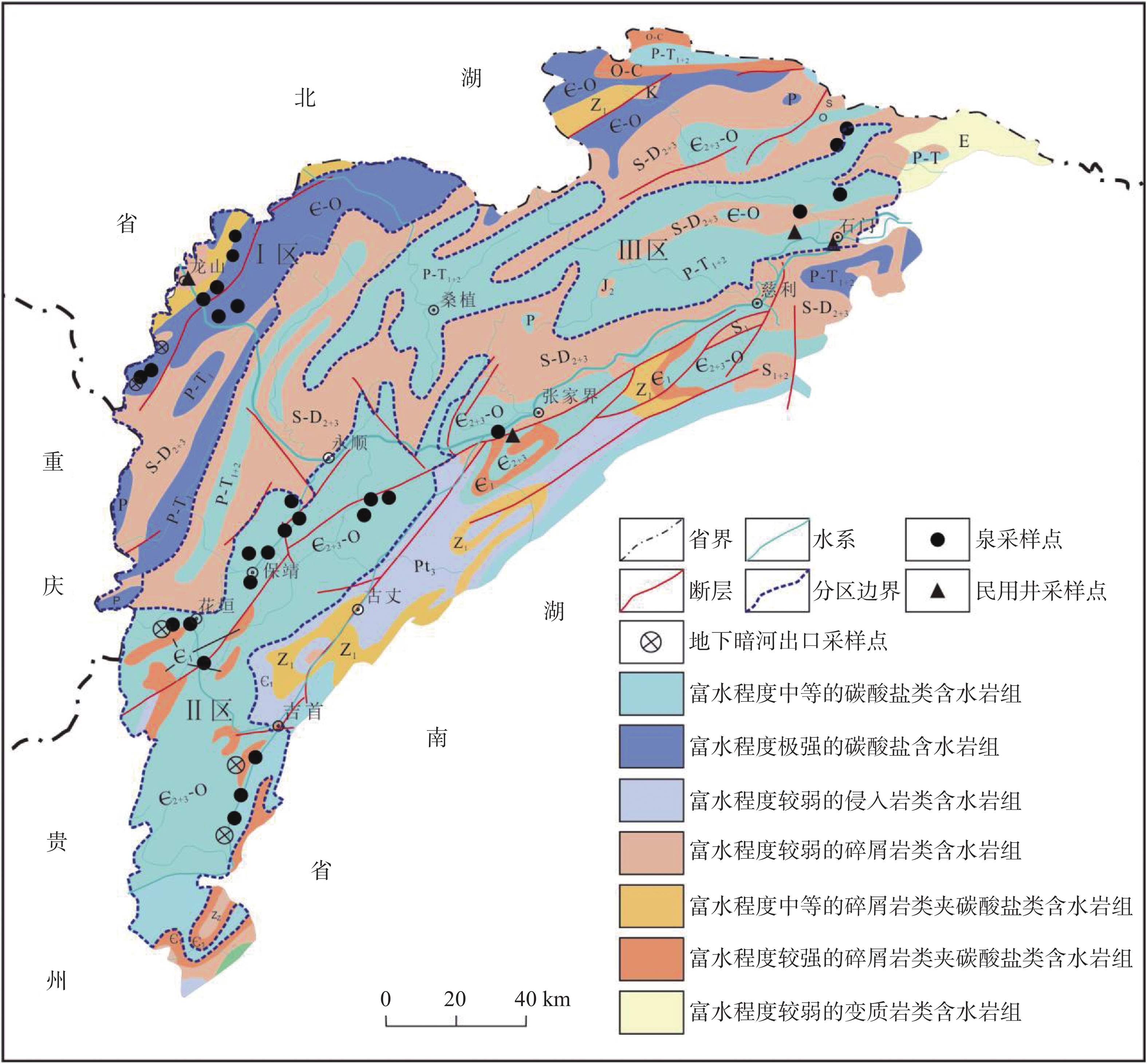Analysis on D/18O and hydrochemical characteristics of karst groundwater in northwestern Hunan Province
-
摘要: 湘西北地区岩溶地下水水化学研究是地下水资源合理开发与利用的保证,文章在全面采集区内地下水水样进行水化学和同位素分析的基础上,利用氘氧同位素和综合水文地球化学研究方法对该区地下水的来源与组分成因进行探讨。结果表明:(1)研究区内岩溶水化学特征整体上三个区之间差异不大,但各区之间地下水组分的来源与成因仍有较大的不同,其主要来源于碳酸盐岩矿物的溶滤,并伴有不同程度的石膏等其他矿物溶滤,在龙山地区(I区)以方解石/白云石、石膏溶滤为主;永顺—凤凰地区(Ⅱ区)内,酉水流域地下水主要以白云岩溶滤为主;武水流域地下水中钙镁离子浓度受灰岩、白云岩溶滤作用共同影响。石门地区(Ⅲ区)主要离子来源于灰岩溶滤,地下水中钠钾离子、氯离子有多种来源;(2)研究区内氘氧同位素体现出明显的大陆效应和高程效应,泉相对井和暗河地下水系统具有相对封闭性,氘盈余则反映泉相对于暗河是一种快循环、短停留时间的系统。Abstract:
Understanding hydrochemistry of karst water in northwestern Hunan is the foundation for reasonable utilization of water resources. The study on the causes of water sources and the evolution process of solute components is of great scientific value and practical significance. However, most of the research on this area has focused on the optimal allocation of water quantity and the evaluation of local water quality in the past few years. There is lack of research on hydrological geochemical characteristics and control factors based on groundwater systems, and hence a need of further research on the systematic understanding and utilization of local karst groundwater. This study takes the karst water system in northwestern Hunan Province as a case, aiming to reveal the characteristics, the evolution law and causes of hydrochemistry in this area. The research findings are hoped to play a positive guiding role in the sustainable development, and utilization and integrated management of regional groundwater resources. On the basis of hydrochemical and isotopic analyses of water samples collected in the study area, the source and composition origin of groundwater in this area have been explored with isotope D and 18O and with the comprehensive hydrogeochemical research method of multivariate statistics and hydrochemistry (piper trilinear diagram and ion scale coefficient). The results show that although there is little difference among three study zone on the whole, the sources and genesis of groundwater components are still quite different. According to the pipper three-line chart and the Gibbs chart, it can be seen that the main component of groundwater mainly derives from the dissolution and leaching of carbonate, accompanied by different degrees of the leaching of gypsum and other minerals. Concentrations of potassium, sodium ions and chloride ions are generally low, which is related to the low content of salt rocks in the carbonate formation and weak effect of evaporative concentration. Because the alternating adsorption of cations is weak, it is not the main influencing factor of the groundwater chemistry in the study area. Longshan area (Zone I), mainly presents the leaching of calcite/dolomite and gypsum. The water abundance in karst aquifers is high and the interaction between water and rock is rapid. In Yongshun-Fenghuang area (Zone II), groundwater in the Youshui basin mainly presents the leaching of dolomite and the concentrations of potassium and sodium ions are affected by the leaching of rock salt. In the Wushui basin, the joint leaching effect of limestone and dolomite that influences the concentrations of calcium and magnesium ions in groundwater, together with the leaching of silicate rock, augments the concentrations of potassium and sodium ions. In Shimen county (Zone III), the main source of ions comes from the leaching of limestone, and there are multiple sources of sodium, potassium, and chloride ions in groundwater. Besides, the recharge source of groundwater in the study area is mainly atmospheric precipitation, groundwater generally replenished directly through sinkholes, karst pipelines, karst funnels, etc. The isotope D and 18O of groudwater in the study area presents obvious continental and elevation effects. It is believed that springs show more closure properties compared with wells and underground river systems. Since the study area is a karst landform in an arc-shaped mountainous area, the terrain is severely cut, and the elevation of the sampling point is not very representative of the average supply elevation of springs and underground river systems. The deuterium surplus reflects that the spring system is the one with a faster cycle and shorter retention compared with the system of underground river. However, the underground river has a longer supply source, a wider range of replenishment, a longer movement time and a longer flow of water underground, and stronger water-rock interaction. -
表 1 研究区地下水水化学统计表
Table 1. Statistical table of groundwater hydrochemistry in the study area
统计项 pH K+ Na+ Ca2+ Mg2+ Cl− ${\rm{SO}}_4^{2-}$ ${\rm{HCO}}_3^{-}$ TDS Ⅰ区 最小值 6.81 0.69 − 28.10 4.68 0.51 2.22 109.83 39.80 最大值 8.46 2.03 11.70 120.00 25.7 15.30 16.10 378.31 157.00 均值 7.84 1.12 2.29 49.25 12.50 2.65 9.09 188.42 76.89 标准偏差 0.44 0.40 3.65 26.82 6.82 4.51 3.95 75.18 31.49 变异系数 0.06 0.36 1.59 0.54 0.55 1.71 0.43 0.40 0.41 Ⅱ区 最小值 6.94 0.08 − 46.20 2.96 0.45 6.85 167.18 72.00 最大值 8.20 11.80 11.30 87.00 50.00 10.40 81.1 402.71 214.00 均值 7.38 2.26 1.45 66.81 28.66 3.40 21.90 269.75 124.46 标准偏差 0.29 2.66 2.74 10.74 13.69 2.59 18.94 62.13 32.50 变异系数 0.04 1.18 1.89 0.16 0.48 0.76 0.86 0.23 0.26 Ⅲ区 最小值 6.60 0.73 − 47.50 2.61 2.24 12.30 128.14 78.10 最大值 8.11 6.97 6.43 128.00 14.20 13.70 69.40 352.68 189.00 均值 7.32 2.23 1.57 87.34 8.17 6.21 34.86 219.93 140.47 标准偏差 0.48 1.92 2.16 29.23 3.28 3.80 18.97 76.99 42.65 变异系数 0.07 0.86 1.38 0.33 0.40 0.61 0.54 0.35 0.30 注:pH无量纲,其余水化学组分单位均为(mg·L−1), “−”表示未检出。
Note: pH is dimensionless. For other hydrochemical components, the units are all mg·L−1,"−" indicates that it is not detected.表 2 岩溶水SAR值计算结果统计
Table 2. Statistics of the SAR value of karst water
区域 项目 SAR Ⅰ区 最大值 3.43 最小值 0 平均值 0.67 Ⅱ区 最大值 0.96 最小值 0 平均值 0.14 Ⅲ区 最大值 0.78 最小值 0 平均值 0.22 表 3 地下水δD-δ18O特征
Table 3. Characteristics of δD-δ18O in groundwater
变化范围/‰ 平均值/‰ δ18O与δD关系 δ18OV-SMOW −6.00~-8.44 −6.88 δD=6.57δ18O+2.74,R2=0.84 δDV-SMOW −36.80~53.66 −42.57 表 4 不同水体氢氧同位素特征及d值
Table 4. Characteristics of hydrogen and oxygen isotopes and d values in different water bodies
类型 δ18O变化范围/‰ δ18O平均值/‰ δD变化范围/‰ δD平均值/‰ d变化范围/‰ d平均值/‰ 泉 −8.44~−6.12 −6.60 −53.66~−38.47 −40.47 9.24~16.74 12.83 井 −6.69~−6.57 −6.63 −43.47~−38.97 −41.22 10.06~13.62 11.84 地下暗河 −7.78~−6.00 −6.80 −51.11~−36.80 −43.77 8.23~11.87 10.62 -
[1] 巩书华, 朱丽芬. 湘西北地质地貌特征对岩溶石漠化影响研究:以张家界市为例[J]. 中国岩溶, 2021, 40(3):504-512.GONG Shuhua, ZHU Lifen. Influence of geological and geomorphologic features on karst rocky desertification in northwestern Hunan Province: A case study of Zhangjiajie City[J]. Carsologica Sinica, 2021, 40(3):504-512. [2] 蒋忠诚, 张晶, 黄超, 容悦冰, 吴亮君. 湘西地质公园岩溶峡谷群成因及其地学意义[J]. 中国岩溶, 2019, 38(2):269-275.JIANG Zhongcheng, ZHANG Jing, HUANG Chao, RONG Yuebing, WU Liangjun. Causes of formation and geo-scientific significance of karst gorge group in Xiangxi geopark[J]. Carsologica Sinica, 2019, 38(2):269-275. [3] 何师意, 周锦忠, 曾飞跃. 岩溶地下河流域地下水资源评价:以湖南湘西大龙洞为例[J]. 水文地质工程地质, 2007(5):33-36. doi: 10.3969/j.issn.1000-3665.2007.05.009HE Shiyi, ZHOU Jinzhong, ZENG Feiyue. Assessment on the karst water resources of Dalongdong underground river catchment of Xiangxi[J]. Hydrogeology & Engineering Geology, 2007(5):33-36. doi: 10.3969/j.issn.1000-3665.2007.05.009 [4] 管清花, 李福林, 王爱芹, 冯平, 田婵娟, 陈学群, 刘丹. 济南市岩溶泉域地下水化学特征与水环境演化[J]. 中国岩溶, 2019, 38(5):653-662.GUAN Qinghua, LI Fulin, WANG Aiqin, FENG Ping, TIAN Chanjuan, CHEN Xuequn, LIU Dan. Hydrochemistry characteristics and evolution of karst spring groundwater system in Jinan[J]. Carsologica Sinica, 2019, 38(5):653-662. [5] 刘再华, 袁道先, 何师意. 岩溶动力系统水化学动态变化规律分析[J]. 中国岩溶, 1999, 18(2):3-8. doi: 10.3969/j.issn.1001-4810.1999.02.001LIU Zaihua, YUAN Daoxian, HE Shiyi. Analysis on the variation of hydrochemistry in karst dynamic system[J]. Carsologica Sinica, 1999, 18(2):3-8. doi: 10.3969/j.issn.1001-4810.1999.02.001 [6] 郭清海. 岩浆热源型地热系统及其水文地球化学判据[J]. 地质学报, 2020, 94(12):3544-3554. doi: 10.3969/j.issn.0001-5717.2020.12.002GUO Qinghai. Magma-heated geothermal systems and hydrogeochemical evidence of their occurrence[J]. Acta Geologica Sinica, 2020, 94(12):3544-3554. doi: 10.3969/j.issn.0001-5717.2020.12.002 [7] 苏春利, 张雅, 马燕华, 刘文波. 贵阳市岩溶地下水水化学演化机制:水化学和锶同位素证据[J]. 地球科学, 2019, 44(9):2829-2838.SU Chunli, ZHANG Ya, MA Yanhua, LIU Wenbo. Hydrochemical evolution processes of karst groundwater in Guiyang City: Evidences from hydrochemistry and 87Sr/86Sr ratios[J]. Earth Science, 2019, 44(9):2829-2838. [8] Andres Marandi, Paul Shand. Groundwater chemistry and the Gibbs Diagram[J]. Applied Geochemistry, 2018, 97: 209-212. [9] 刘伟江, 袁祥美, 张雅, 马燕华, 苏春利. 贵阳市岩溶地下水水化学特征及演化过程分析[J]. 地质科技情报, 2018, 37(6):245-251. doi: 10.19509/j.cnki.dzkq.2018.0631LIU Weijiang, YUAN Xiangmei, ZHANG Ya, MA Yanhua, SU Chunli. Hydrochemical characteristics and evolution of karst groudwater in Guiyang City[J]. Geological Science and Technology Information, 2018, 37(6):245-251. doi: 10.19509/j.cnki.dzkq.2018.0631 [10] 侯俊华, 谢春雷, 张冬. 东滩矿奥陶系灰岩地下水水化学特征与成因[J]. 山东煤炭科技, 2021, 39(10):177-180. doi: 10.3969/j.issn.1005-2801.2021.10.060HOU Junhua, XIE Chunlei, ZHANG Dong. Hydrochemical characteristics and genesis of underground water of Ordovician limestone in Dongtan mine[J]. Shandong Coal Science and Technology, 2021, 39(10):177-180. doi: 10.3969/j.issn.1005-2801.2021.10.060 [11] 王东海, 李春, 高焰, 李大秋. 人类活动对济南泉域地下水水质的影响[J]. 中国环境监测, 2003, 19(5):18-21. doi: 10.3969/j.issn.1002-6002.2003.05.006WANG Donghai, LI Chun, GAO Yan, LI Daqiu. Effect on groundwater quality of Jinan spring region by human activity[J]. Environmental Monitoring in China, 2003, 19(5):18-21. doi: 10.3969/j.issn.1002-6002.2003.05.006 [12] 唐金平, 胡漾, 张强, 何文君, 朱志强, 牛佚凡. 湔江冲洪积扇地下水氮分布特征及灌溉用水适宜性评价[J]. 中国农村水利水电, 2019(10):28-33. doi: 10.3969/j.issn.1007-2284.2019.10.006TANG Jinping, HU Yang, ZHANG Qiang, HE Wenjun, ZHU Zhiqiang, NIU Yifan. Characteristics of groundwater nitrogen distribution and suitability evaluation of irrigation water in alluvial-diluvial fan of Jianjiang river[J]. China Rural Water and Hydropower, 2019(10):28-33. doi: 10.3969/j.issn.1007-2284.2019.10.006 [13] 贾超, 王丛, 刘森, 杨霄, 刘文, 高帅, 朱恒华. 济南西部冲积平原地下水水文地球化学特征研究[J]. 水利水电技术(中英文), 2022, 53(3):49-60.JIA Chao, WANG Cong, LIU Sen, YANG Xiao, LIU Wen, GAO Shuai, ZHU Henghua. Study on hydrogeochemical characteristic of groundwater in the alluvial plain of western Jinan[J]. Water Resources and Hydropower Engineering, 2022, 53(3):49-60. [14] 张世殊, 冉从彦, 许模, 郭建平. 开茂水库岩溶地下水水文地球化学特征研究[J]. 地下水, 2020, 42(5):17-20. doi: 10.19807/j.cnki.DXS.2020-05-005ZHANG Shishu, RAN Congyan, XU Mo, GUO Jianping. Hydrochemical characteristics of karst water in Kaimao reservoir[J]. Ground Water, 2020, 42(5):17-20. doi: 10.19807/j.cnki.DXS.2020-05-005 [15] 仝晓霞, 刘存富. 西北干寒区冰雪融水氢氧同位素水文地质意义[J]. 环境科学与技术, 2018, 41(1):57-63. doi: 10.19672/j.cnki.1003-6504.2018.01.011TONG Xiaoxia, LIU Cunfu. Hydrogeological significance of hydrogen and oxygen isotopes in ice and snow melting water in northwest arid region[J]. Environmental Science & Technology, 2018, 41(1):57-63. doi: 10.19672/j.cnki.1003-6504.2018.01.011 [16] Zhang Yinghua, WU Y, SU J, WEN X, LIU F. Groundwater replenishment analysis by using natural isotopes in Ejina basin, Northwestern China[J]. Environmental Geology, 2006, 48(1):6-14. doi: 10.1007/s00254-004-1214-x [17] 赵家成, 魏宝华, 肖尚斌. 湖北宜昌地区大气降水中的稳定同位素特征[J]. 热带地理, 2009, 29(6):526-531. doi: 10.3969/j.issn.1001-5221.2009.06.004ZHAO Jiacheng, WEI Baohua, XIAO Shangbin. Stable isotopic characteristics of atmospheric precipitation from Yichang, Hubei[J]. Tropical Geography, 2009, 29(6):526-531. doi: 10.3969/j.issn.1001-5221.2009.06.004 [18] 黄一民, 章新平, 唐方雨, 吴华武, 张剑明. 长沙大气降水中稳定同位素变化及过量氘指示水汽来源[J]. 自然资源学报, 2013, 28(11):1945-1954. doi: 10.11849/zrzyxb.2013.11.011HUANG Yimin, ZHANG Xinping, TANG Fangyu, WU Huawu, ZHANG Jianming. Variations of precipitation stable isotope and vapor origins revealed by deuterium excess in Changsha[J]. Journal of Natural Resources, 2013, 28(11):1945-1954. doi: 10.11849/zrzyxb.2013.11.011 [19] 张明亮. 滇东黔西地下水氢氧同位素特征[J]. 四川地质学报, 2019, 39(3):508-511. doi: 10.3969/j.issn.1006-0995.2019.03.032ZHANG Mingliang. The δ18O and δD values of groundwater in east Yunnan and west Guizhou[J]. Acta Geologica Sichuan, 2019, 39(3):508-511. doi: 10.3969/j.issn.1006-0995.2019.03.032 [20] 焦艳军, 王广才, 崔霖峰, 韩永, 胡亚男, 陈鲁. 济源盆地地表水和地下水的水化学及氢、氧同位素特征[J]. 环境化学, 2014, 33(6):962-968. doi: 10.7524/j.issn.0254-6108.2014.06.023JIAO Yanjun, WANG Guangcai, CUI Linfeng, HAN Yong, HU Yanan, CHEN Lu. Characteristics of hydrochemistry and stable hydrogen, oxygen isotopes in surface water and groundwater in Jiyuan basin[J]. Environmental Chemistry, 2014, 33(6):962-968. doi: 10.7524/j.issn.0254-6108.2014.06.023 [21] Joussaume S, Sadourny R, Jouzel J. A general-circulation model of water, of water isotope cycles in the atmosphere[J]. Nature, 1984, 311(5981):24-29. doi: 10.1038/311024a0 [22] 尹观, 倪师军. 地下水氘过量参数的演化[J]. 矿物岩石地球化学通报, 2001(4):409-411. doi: 10.3969/j.issn.1007-2802.2001.04.057YIN Guan, NI Shijun. Deuterium excess parameter evolution in ground water[J]. Bulletin of Mineralogy, Petrology and Geochemistry, 2001(4):409-411. doi: 10.3969/j.issn.1007-2802.2001.04.057 [23] Long X, Sun Z Y, Zhou A G, Liu D L. Hydrogeochemical and isotopic evidence for flow paths of karst waters collected in the Heshang cave, Central China[J]. Journal of Earth Science, 2015, 26(1):149-156 -




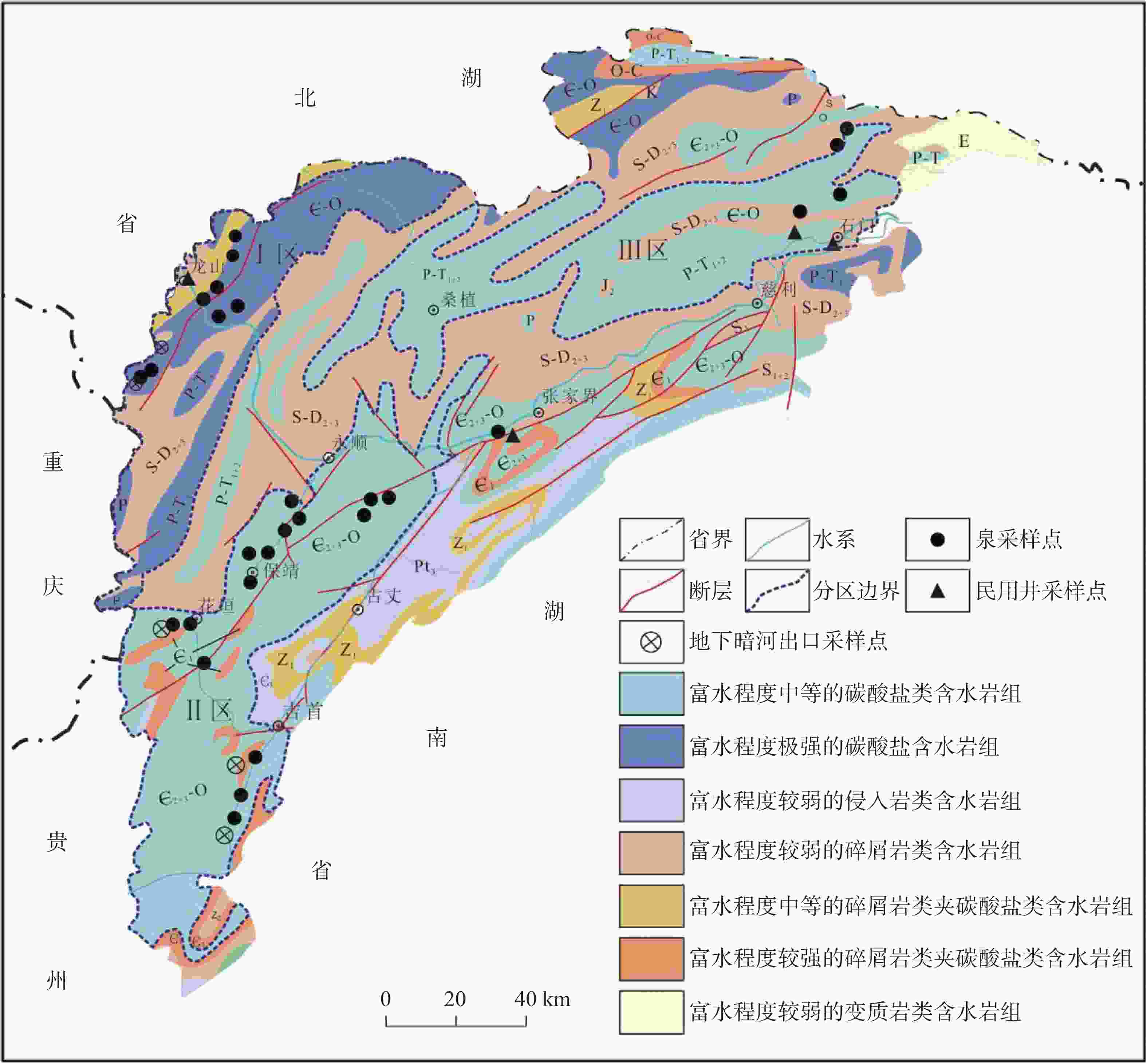
 下载:
下载:
